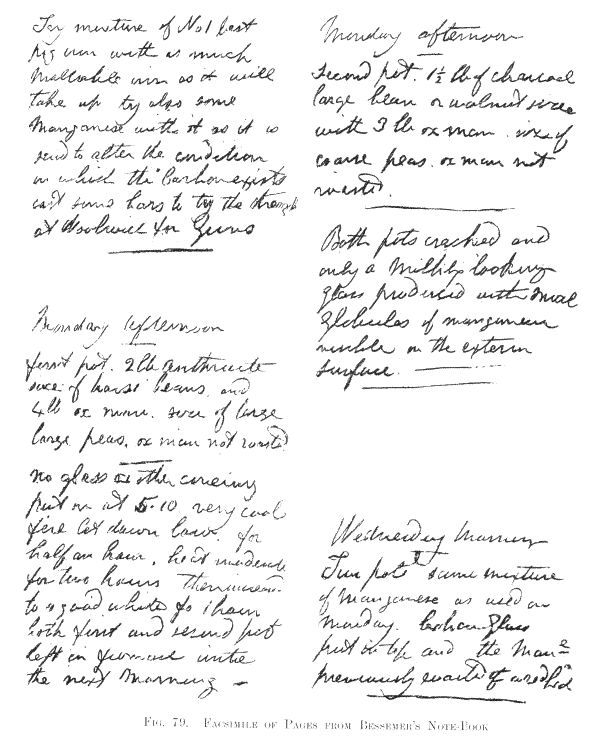of pure metallic manganese when exposed to ordinary atmospheric influence, as the manganese would be protected by the iron present. This mode of producing an alloy of iron and manganese, in almost any assignable proportions, appeared to me to be such an important step in advance as to render all further experiments in making Heath's pure carburet of manganese quite unnecessary; these ideas were at once jotted down in my pocket-book, and simply embody the first rough views taken of this important manufacture. The memoranda referred to we photographically reproduced in Fig. 79, Plate XXXV.

With reference to Bethel's patent coke, I may mention that this coke is made by the destructive distillation of coal-tar in closed retorts, which leaves a porous hard coke which is almost pure carbon. This process would have been excellently adapted for the reduction of oxide of manganese on a large scale, and such a system of coke-making in a retort would have been far less expensive than Heath's crucible process. What I wanted to obtain, however, was the substance I had designated "artificial ore of manganese and iron." Such artificial ore could be smelted like other iron ores, and thus offered all the prospective advantages of quantity and cheapness. This particular scheme I never lost sight of until it culminated in the production of ferro-manganese at Glasgow. Since my invention was kept in abeyance, so far as steel-making from British iron was concerned, I was desirous of making a series of experiments on all the rich alloys of iron and manganese. I, therefore, had my furnace enlarged and the draught improved. I then applied to Messrs. Bird and Company, of London, who were agents for the Workington Hematite Iron Company, to obtain for me some of their pure hematite ore for my experiments. There was some delay in getting this ore, and in the meantime both Mr. Martien's and Mr. Mushet's patents were published. Then, for the first time, I realised that an obstacle had been created, which might prevent my using manganese in my process in any and every form in which that metal was known, or had previously been in public use. Nevertheless, I felt not the slightest hesitation in making use of spiegeleisen, or any other manganesian pig-irons, which were covered by my prior patents. I was, however, unfortunately diverted for the time from the pursuit of the richer alloys of manganese which would have prevented all those troubles met with in producing steel of sufficient mildness for plates, so deeply engrossed did I become in the introduction of my process to the trade, and in keeping watch against the many attempts to encroach on my rights. Coupled with these there was constant and laborious work at the drawing-board in making the original drawings for my own further improvements, and in the development of the many mechanical devices necessary to the commercial use of my invention on a large scale. With all these imperative calls on my time, something had to go to the wall, and the rich manganesian alloys were for the time crowded out. In this busy year -- that is, from September 1856 to November 1857 -- I had taken out eleven new patents. I had settled the mechanical details of each one, and had personally made the whole of the drawings for the eleven specifications. Every day had its new labours, and every day the need for these rich alloys of manganese became more evident.
About this time I had a long conversation on this subject with Mr. William Galloway, one of the partners in our Sheffield firm, and we seriously thought of putting up a blast furnace for making rich manganesian pig-iron. Mr. Galloway had some land at Runcorn, on the Mersey, which he suggested should be utilised for this purpose as a private speculation of our own. I made many inquiries about manganese mines at the "Mining Record" Office, and got a good deal of useful information from Mr. Robert Hunt, the indefatigable head of that most valuable institution. My inquiries and numerous visits on the subject awakened a deep interest in Mr. Hunt, and before the summer was over it was arranged that I should accompany him in his usual annual visit to the principal tin and other mines in Cornwall. I much needed this little holiday, and Mr. Hunt drove me nearly all round the county of Cornwall in an open phaeton, a journey full of deep interest to me. My friend -- for so I am proud to call him was a positive living encyclopaedia, and neither the longest journey, nor the lonely parlour of the village inn, was ever dreary with such an agreeable companion. We visited some of the manganese mines, which were not very promising, being situated in localities far removed from shipping ports, to which their output must have been transported by horse and cart over bad roads.
While Mr. Hunt pursued his professional duties, I made a short halt at Penzance, and rambled over the enormous granite rocks leading down to Land's End. At some works in the district I found a pair of dwarf serpentine columns of great beauty, which I purchased as a memento of this most interesting
| Previous chapter/page | Back | Home | Email this | Search | Discuss | Bookmark | Next chapter/page |